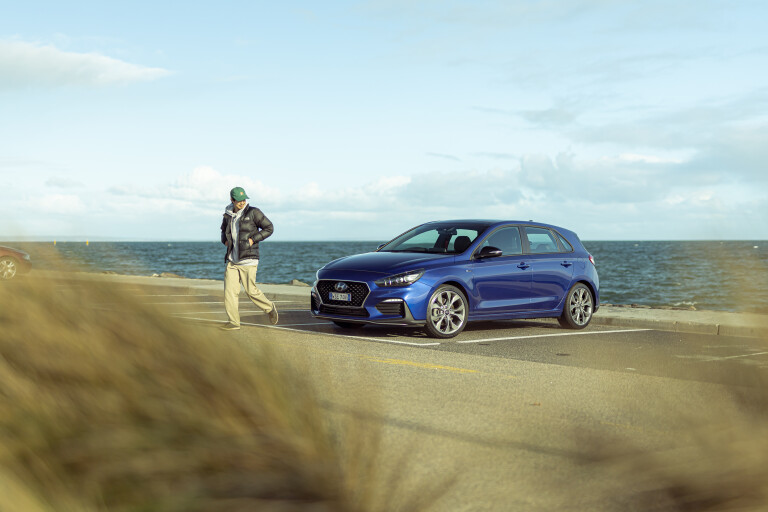
Score breakdown
Things we like
- Steering weight and accuracy
- Strong powertrain
- Overall ease-of-use
Not so much
- Lane-keeping system can be heavy-handed
- Android Auto integration doesn't use full screen
- Occasionally firm
How does the keenly-positioned Hyundai i30 stack up after half a decade on the Australian market?
In its pre-updated SR-badged guise, the mid-range Hyundai i30 was seemingly the default answer to any warm hatch question.
It’s now a familiar and established player on local shores, but despite rivals since muscling in with a flock of younger competition, the updated 2022 i30 N-Line Premium is still worthy of consideration.

Positioned below the ballistic i30 N variants, the i30 N-Line delivers more rounded, polished and accessible urban dynamics bundled with a good level of standard equipment.
Even within the N-Line model, however, there are more choices to make. Premium, or non-Premium? Manual or dual-clutch auto?
The car we’re driving today is an N-Line Premium Auto hatch and represents the most premium offering in the mainstream, non-N, i30 range.
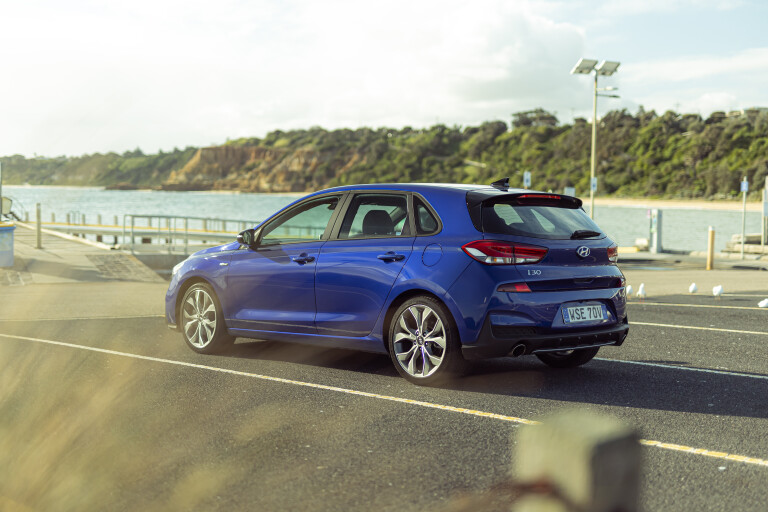
Pricing and features
N-Line variants of the Hyundai i30 open at $29,420 before on-road costs for the non-Premium manual hatchback.
Add $2000 for the seven-speed dual-clutch transmission, or add $4800 to step up into the Premium manual vehicle.
The dual-clutch Premium car tested here tops the range at $36,220 plus on-road costs but undercuts the most affordable flagship i30 N by $8280.
Opting for the Premium-spec vehicles sees the standard 8.0-inch infotainment screen swell to a 10.25-inch widescreen, adds an Infinity seven-speaker premium audio system, panoramic sunroof, powered driver’s seat adjustment, heated and ventilated front seats and an auto-dimming electro-chromatic mirror.
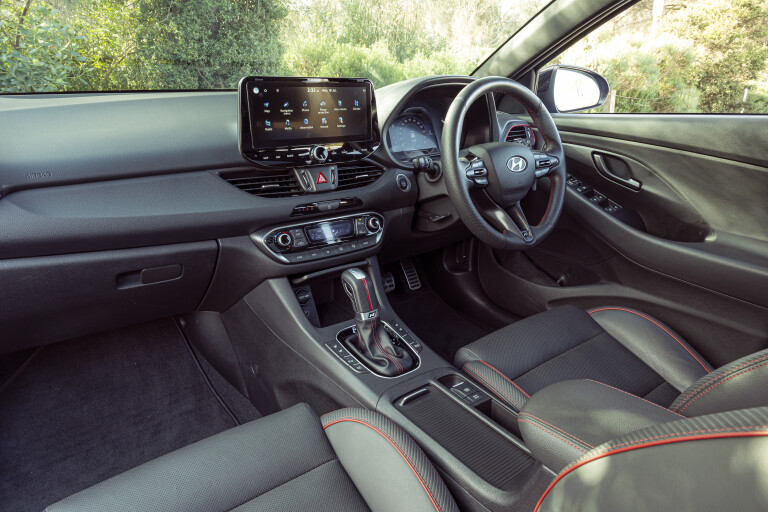
The N-Line doesn’t gain the i30 N’s bombastic 2.0-litre powerhouse, instead it’s powered by a smaller 1.6-litre turbocharged four-cylinder producing a stout 150kW/265Nm.
Key equipment fitted as standard includes: a 7.0-inch digital driver display, Apple CarPlay and Android Auto connectivity, 18-inch alloy wheels, Michelin Pilot Sport 4S tyres, sport alloy pedals, N-Line exclusive interior with leather-appointed trim plus N-Line gear knob and steering wheel, LED front and rear lights, and an N-Line exclusive rear diffuser.
All i30 N-Lines come equipped with seven airbags comprising dual front, front-side, full-length curtains and one for the driver’s knee.
They are also fitted with Hyundai’s SmartSense suite of active safety features, comprising driver attention warning, forward collision avoidance assist, lane-keep assist, lane following assist and adaptive cruise control with stop-and-go functionality (although the latter is not available on manual cars).
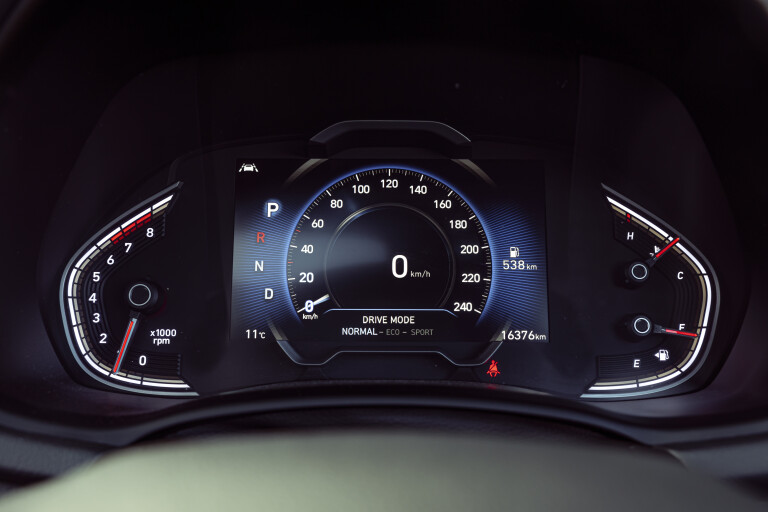
Comfort and space
A prior mid-life update gave the i30 a helping of modernity, adding a 7.0-inch digitised information display to the previously analogue instrument cluster.
The widescreen 10.25-inch infotainment unit commands attention atop the centre stack but, elsewhere, there is a genuinely pleasing mix of switchgear shortcuts to virtually all essential functions.
Lashings of red around the air vents, stitching and on the seatbelts add some colour to the cabin atmosphere. It’s a nice place to be with decent quality materials as well as solid fit and finish.
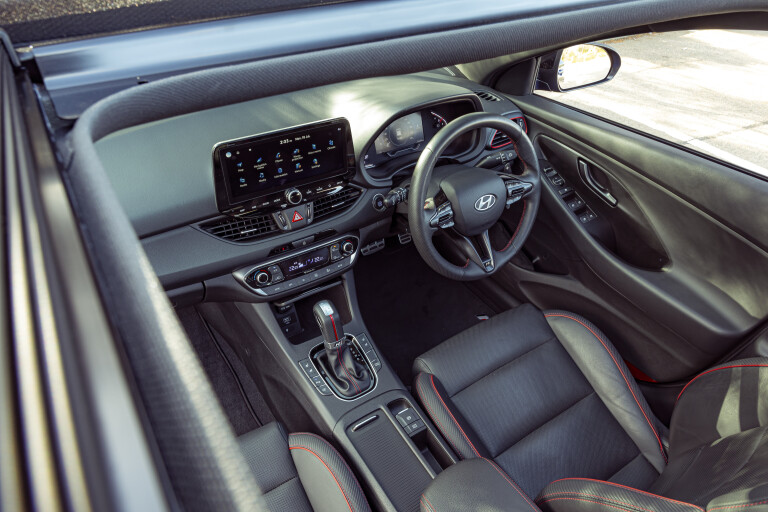
A leather-wrapped steering wheel adds a welcome dash of luxury and feels nice in the hands. The leather-trimmed front seats are supportive with some welcome bolstering, though not so much as to be cause for discomfort on long drives.
There’s a wireless phone charger under the centre stack along with a 12V plug and a USB-A plug for phone connectivity. There are two central cup holders plus a thin bottle holder in each door. Apple device owners can make use of wireless Apple CarPlay, though Android Auto remains a wired affair.
Moving to the second row, there is an agreeable amount of space for adult-sized passengers in the outboard seats. At 175cm tall, seated behind my own driving position, there is headroom, knee and toe room to spare, though taller occupants may risk their knees brushing against the plastic-sheathed seatbacks.
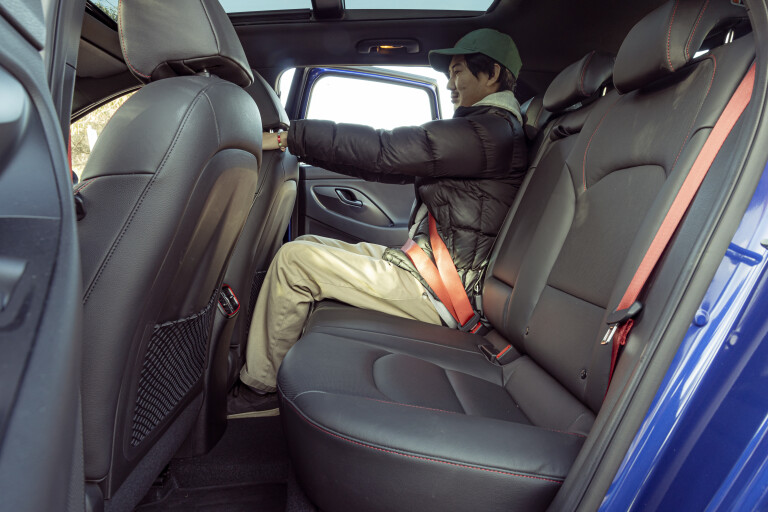
Rear-facing air vents are a welcome nicety, however, and there is another bottle holder to be found in each door pocket.
Further yonder, opening the rear hatch reveals a generous 395 litres of cargo space, 100 litres more than a Mazda3 hatch and 178 litres more than a Toyota Corolla hatch.
That’s also, perhaps counterintuitively, 21 litres greater than the Hyundai Kona small SUV. If that’s not enough, stowage space extends to 1301 litres with the 60:40 rear seats folded.
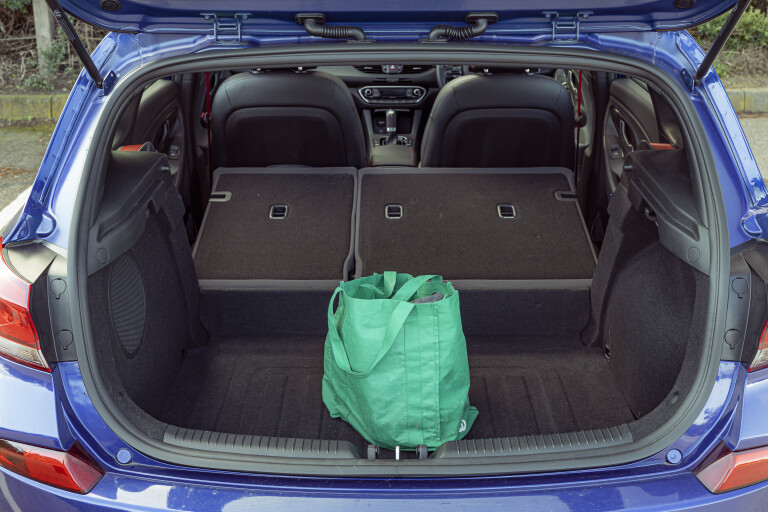
On the road
The turbocharged 1.6-litre engine, unique to the N-Line among the i30 range, produces a respectable 150kW at 6000rpm and a peak of 265Nm from as little as 1500rpm. It’s not the most charismatic unit around, with an agreeable buzzing engine note, but it’s tremendously effective.
A claimed 0-100km/h time of 7.5-seconds is decent for the class and there’s genuine fun to be found in sprightly zipping around town. The throttle is alert and responsive, with good powertrain calibration between the engine and gearbox.
There are some hiccups from the transmission at low speeds in the lower gears but, once up to a cruise, it’s a smooth and intuitive unit that will happily climb up and down cogs as needed.

The N-Line’s sporty positioning has it fitted with stiffer springs that ride 5mm lower than the pedestrian i30 variants. Matched with a localised suspension tune and Michelin Pilot Sport 4S tyres, it’s a capable and effective package that’s genuinely fun to zip around town in.
While modern electronic steering systems are trending towards a light feeling in the hands, the N-Line’s steering is direct and nicely weighted, even in the default driving mode.
The tactile steering firms up progressively in your hands as you wind and unwind lock through a corner, and communicates the front end’s grip levels with clarity. Sport mode dials up the steering weight again, perhaps needlessly so as the default mapping feels rather good.
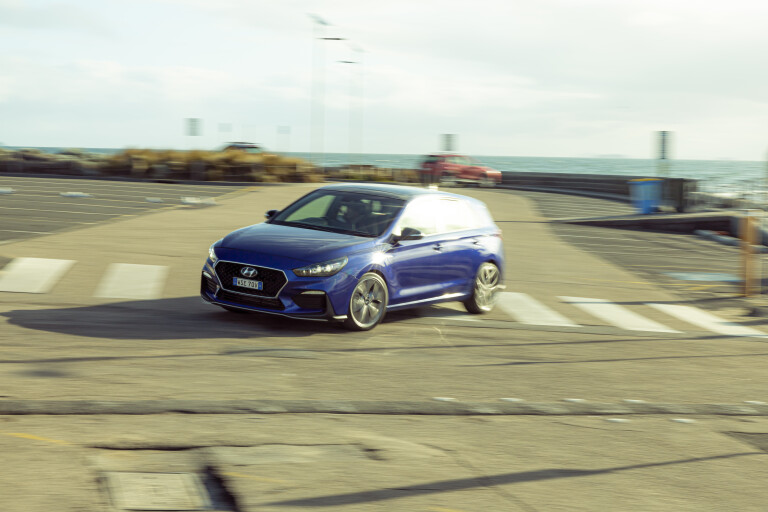
Brakes, too, are strong and well-matched to the N-Line’s pace, with larger 305mm rotors up front.
The damping has an underlying firmness that effectively mitigates body roll through corners and feels great when driving with a bit of verve. There’s sophistication there, too, with a nicely judged compression effect on large bumps with little crashing or overt harshness transferred to the driver and occupants.
Hyundai claims an official combined consumption figure of 7.5L/100km, however, our testing period registered 8.6L around town.
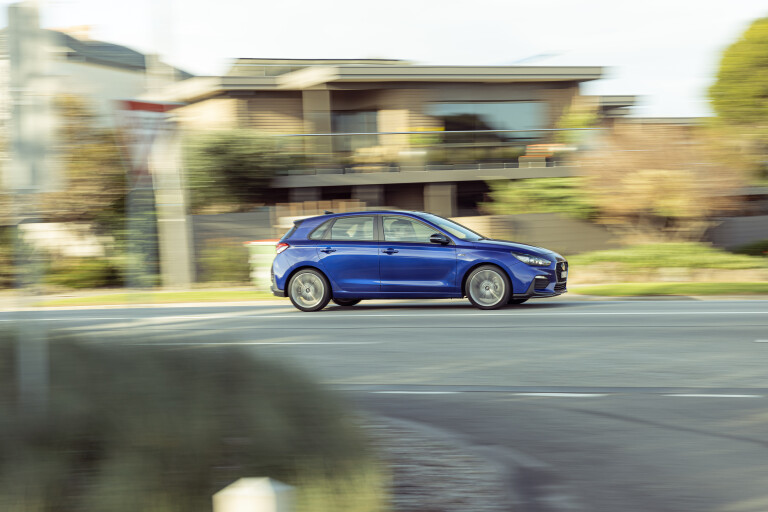
Ownership
All new i30s are covered by Hyundai’s five-year, unlimited-kilometre warranty, with various extra-cost schemes spanning pre-paid servicing (three years or 30,000km, four years or 40,000km and five years or 50,000km), roadside assist plans and even lifetime capped-price servicing schemes.
All new Hyundais include a complimentary 12 months of roadside assistance, which resets every time you visit a Hyundai dealership for servicing.
One downside to the N-Line’s turbocharged engine is shorter service intervals of every 12 months or 10,000km, as opposed to the 12 months/15,000km intervals of naturally aspirated variants.

VERDICT
The 2022 Hyundai i30 N-Line remains a capable and compelling package for those who love driving. It’s not as sharp as the ballistic i30 N but cuts a finer line between daily useability, accessibility and friendliness with a genuinely fun dynamic package.
It’s an easy car to live with, particularly with the seven-speed dual-clutch, and will rarely fail to put a smile on your face. For a mid-$30K hatchback, the i30 N-Line delivers a good deal of tech and equipment and, despite there being younger rivals available, still represents a high watermark for warm hatch dynamics.
As a deeply considered package geared towards the discerning driving enthusiast, it more than delivers more than an air of Namyang magic for a significant cost saving.
2022 Hyundai i30 N-Line Premium hatch DCT specifications
| Body | five-door, five-seat hatch |
| Drive | front-drive |
| Engine | 1591cc inline-4, DOHC, 16v, turbo |
| Bore/Stroke | 75.6mm x 89.0mm |
| Compression | 10:01 |
| Power | 150kW @ 6000rpm |
| Torque | 265Nm @ 1500-4500rpm |
| Fuel Consumption | 8.6L/100km |
| Weight | 1344kg |
| Power/Weight | 112kW/tonne |
| Transmission | 7-speed dual-clutch |
| Suspension | Strut, coil spring, anti-roll (f); multi-links, coil spring, anti-roll ® |
| L/W/H | 4345mm/1795mm/1453mm |
| Wheelbase | 2650mm |
| Tracks | 1549mm/1563mm |
| Steering | electrically-assisted rack-and-pinion |
| Brakes | 305mm ventilated disc, single-piston caliper (f); 284mm solid disc, single-piston floating caliper |
| Wheels | 18 x 7.5-inch |
| Tyres | 225/40 R18, Michelin Pilot Sport 4S |
| Price | $36,220 |
Score breakdown
Things we like
- Steering weight and accuracy
- Strong powertrain
- Overall ease-of-use
Not so much
- Lane-keeping system can be heavy-handed
- Android Auto integration doesn't use full screen
- Occasionally firm



COMMENTS